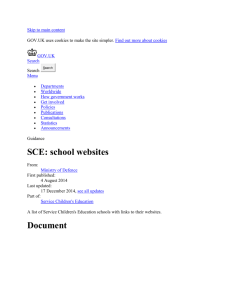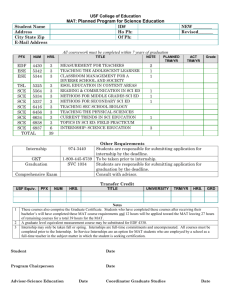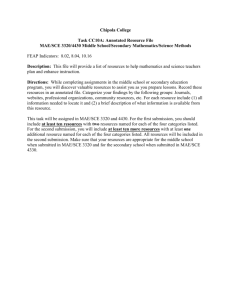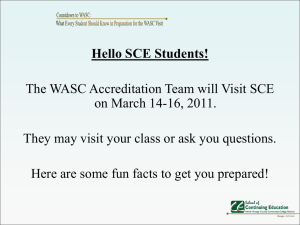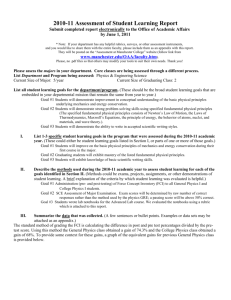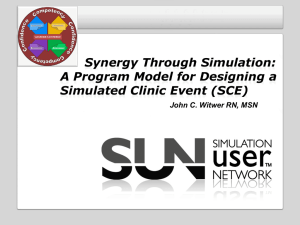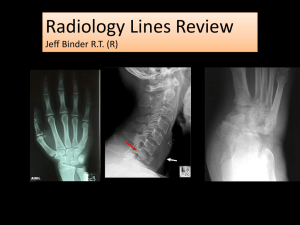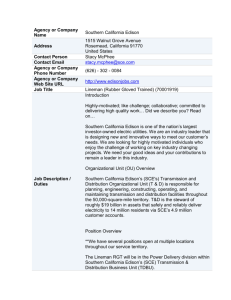UNITED STATES OF AMERICA - Southern California Edison
advertisement
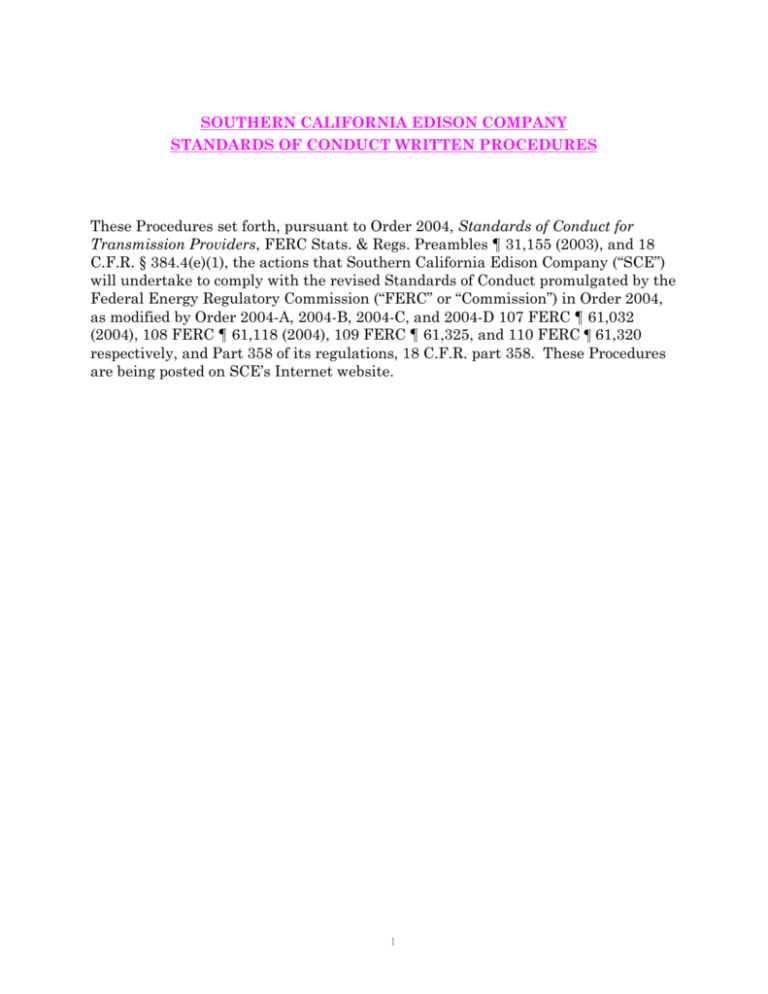
SOUTHERN CALIFORNIA EDISON COMPANY STANDARDS OF CONDUCT WRITTEN PROCEDURES These Procedures set forth, pursuant to Order 2004, Standards of Conduct for Transmission Providers, FERC Stats. & Regs. Preambles ¶ 31,155 (2003), and 18 C.F.R. § 384.4(e)(1), the actions that Southern California Edison Company (“SCE”) will undertake to comply with the revised Standards of Conduct promulgated by the Federal Energy Regulatory Commission (“FERC” or “Commission”) in Order 2004, as modified by Order 2004-A, 2004-B, 2004-C, and 2004-D 107 FERC ¶ 61,032 (2004), 108 FERC ¶ 61,118 (2004), 109 FERC ¶ 61,325, and 110 FERC ¶ 61,320 respectively, and Part 358 of its regulations, 18 C.F.R. part 358. These Procedures are being posted on SCE’s Internet website. 1 § 358.4(a)(1): “Except in emergency circumstances affecting system reliability, the transmission function employees of the Transmission Provider must function independently of the Transmission Provider's Marketing or Energy Affiliates’ employees.” Southern California Edison Company (SCE) has required transmission function employees to function independently of its wholesale marketing employees since 1997, pursuant to the FERC’s Standards of Conduct promulgated under the OpenAccess Same-Time Information System and Standards of Conduct, Order No. 889, 1991-96 FERC Stats. & Regs., Regs. Preambles ¶ 31,035 (1996). SCE’s practice for ensuring independent functioning includes both operational separation and physical separation, as well as separate intracorporate reporting structures. Transmission Function SCE has transferred operational control of its transmission system to the California Independent System Operator Corporation (CAISO). SCE also is not a control area operator. Through the CAISO Tariff on file with the Commission, the CAISO controls and provides open access transmission service, including service on the SCE transmission system. Under normal operations, the scheduling and dispatch of the SCE transmission system is controlled by the CAISO. In addition, market participant access to the SCE transmission system, including any access by any SCE Marketing or Energy Affiliate, must normally be arranged through the CAISO and is not available through SCE. SCE therefore has limited responsibility associated with transmission service, and more limited access to commercially valuable information about the wholesale electric market and the California transmission system than a Transmission Provider that is not a CAISO member. The SCE Transmission and Distribution Business Unit (TDBU) primarily performs the transmission function on behalf of SCE. The SCE TDBU includes the following major organizations: Business Process & Technology Integration; Engineering and Technical Services; Federal Regulation and Contracts; Finance and Administrative Services; Planning, Communications and CPUC Regulation; Power Delivery; Project Management; Shop Services and Instrumentation Division; and Oversight & Quality Assurance, each of which reports to the Senior Vice President of Transmission & Distribution, who in turn reports to SCE’s President. The management of SCE’s internal Marketing Affiliate and TDBU do not overlap through the SCE Vice Presidential level and there is no overlap with external Energy Affiliate management. More specific descriptions of the roles of the organizations that have access to significant transmission information are provided below: 2 The SCE Grid Control Center (GCC), which reports to the TDBU Power Delivery organization, is responsible for the overall operation and monitoring of SCE’s transmission system, and is the primary point of contact with the CAISO for dispatching of selected transmission lines and equipment that are owned or operated by SCE. The status and availability of the SCE transmission interconnections with adjacent utilities, transmission lines and substations are normally reported through the SCE GCC to the CAISO. The GCC employees are located in Building AG at a separate secured facility in Alhambra, California, approximately six miles from SCE’s General Office Complex in Rosemead. (The General Office Complex consists of four facilities -- GO1, GO2, GO3, GO4.) Access to the GCC is controlled by keycard access and a security guard to allow access by Marketing or Energy Affiliate employees only if they are authorized by a GCC employee, and if they are escorted by an authorized employee. This is the same access restriction as would be applied to a third party. The SCE Transmission & Interconnection Planning organization, which reports to the TDBU Engineering and Technical Services organization, is responsible for transmission facility performance and expansion planning for SCE. Its responsibilities include developing facility performance criteria, maintaining power quality, and conducting post-disturbance reviews. It coordinates with the Western Electricity Coordinating Council and the CAISO on transmission system planning issues. It also performs reliability studies for the CAISO in order to make recommendations to the CAISO regarding transmission expansions or upgrades. System Impact Studies and Facilities Studies performed under the CAISO Tariff, Transmission Owner Tariff and Wholesale Distribution Access Tariff (WDAT) are also performed by Transmission & Interconnection Planning. Transmission & Interconnection Planning personnel are located in the third floor of GO3, located across the street from GO1. Access to GO3 is restricted by a security guard to allow access by Marketing or Energy Affiliate employees only if they are authorized by a Transmission & Interconnection Planning employee, and if they are escorted by an employee or guard. This is the same access restriction as would be applied to a third party. SCE provides FERC-jurisdictional wholesale distribution service to several customers, including SCE, through the SCE WDAT on file with the Commission. The SCE Grid Contracts organization, which reports to the TDBU Federal Regulation and Contracts organization, is responsible for processing and administering requests for service under its WDAT, including such requests from SCE-owned or controlled generation. Such service is limited to service to and from the CAISO Grid over non-CAISO facilities. Grid Contracts also processes generator interconnection requests received from the CAISO pursuant to the CAISO Tariff, and grid expansion requests pursuant to the Transmission Owner Tariff. The ISO/FERC Regulation organization, which also reports to the TDBU Federal Regulation & Contracts organization, is responsible for the interface with the 3 CAISO, managing Market Design activities, and TDBU activities related to the Commission, Western Electricity Coordinating Council, North American Electric Reliability Council, North American Energy Standards Board, federal legislation, Regional Transmission Organization development and transmission rate support. The SCE Grid Contracts and ISO/FERC Regulation personnel are located in a separate area on the fourth floor of GO1. There is no physical barrier blocking access by Marketing Affiliate or Energy Affiliate employees to the Grid Contracts and ISO/FERC Regulation area, but Marketing and Energy Affiliate employees are required to remain outside that area. The area is posted with signs reminding employees of the restricted access. SCE Grid Contracts and ISO/FERC Regulation employees have been directed to keep transmission information in locked files when not being accessed by authorized personnel. As discussed further below, SCE’s ES&M employees – its only Energy or Marketing Affiliates who normally do business in the GO facilities -- wear distinctive ID badges to identify them as Marketing or Energy Affiliate employees who are unauthorized to be in the Grid Contracts and ISO/FERC Regulation area. The TDBU Project Management group is responsible for managing the development and implementation of grid-related projects, including directing final design, procurement, bid evaluation, licensing, construction, and satisfaction of regulatory requirements within budget and on schedule. The group manages all construction activities from the extra-high voltage transmission grid, as well as all substation facilities and the substation automation project. The group also manages construction of new customer-requested facilities, including third-party generation interconnections, relocations, and modifications. The TDBU Project Management group works in a facility in Fullerton, California, located over 20 miles away from the GO facilities. Marketing and Energy Affiliate employees are allowed access to this facility only if they are authorized by a Project Management employee, and are escorted by an authorized employee or guard. This is the same access restriction as would be applied to a third party. SCE Marketing and Energy Affiliates SCE engages in wholesale power transactions for the sole purpose of serving the interests of its retail ratepayers in southern California. Although SCE divested its gas-fired thermal power plants as a condition of California’s electric market restructuring program, it has retained nuclear, coal and hydroelectric generation as well as contract resources. Contract resources include utility and QF power purchase agreements that were entered into prior to restructuring, as well as contract resources acquired by the California Department of Water Resources during the Western energy crisis of 2000-2001 and allocated to SCE for administration and other contract resources acquired in the last two years. SCE’s current wholesale purchases and sales are needed to shape supply resources to serve the demand of retail customers. 4 SCE’s Marketing Affiliate (and thus also its internal Energy Affiliate) is SCE’s Energy Supply & Management (ES&M) division. ES&M consists of the units described below. The Power Contracts Unit is responsible for the forward purchase and sale of power resources using contracts to serve SCE’s forecast customer demand. In addition, the Power Contracts Unit includes an active trading group that engages in forward and day-of transactions for power and gas. The Energy Operations Unit staff makes real-time sales and may adjust the generation dispatch schedule to reflect changes in customer load. The primary responsibilities of personnel in this division are (i) to ensure that electric supplies scheduled with the CASIO are accurate, timely, and consistent with SCE’s leastcost dispatch objectives; (ii) to accurately and timely schedule natural gas supplies with gas transporters and gas storage providers; (iii) to attempt to balance, as appropriate, SCE’s hourly Residual Net Short and Residual Net Long positions during each operating day through transacting in the ISO’s hour-ahead market; and (iv) to redispatch SCE’s generation portfolio as necessary based on changing prices, system conditions and CAISO orders, consistent with contract terms and operating constraints. In the course of balancing SCE’s hourly positions, the Real-Time Operations group, a subgroup of Energy Operations, may engage in power sales. The Day-Ahead Operations group builds and submits generation bids and schedules to the CAISO. Energy Planning’s function is to serve SCE’s native load in the least-cost manner possible, by performing a wide variety of planning and support activities for ES&M and other SCE departments related to SCE’s operations and corporate planning and budget requirements. Demand Forecasting employees are responsible for forecasting SCE customer demand. Regulation & Compliance employees review, maintain, and update ES&M compliance matters, and manage and coordinate regulatory compliance audits. Demand Resource Integration employees are responsible for integrating SCE’s retail demand reduction and demand management programs with ES&M’s energy procurement activities. ES&M personnel, and a limited number of shared personnel from SCE’s Risk Operations Division of Risk Control, Power Procurement Finance and IT support who are not Marketing Energy Affiliates, are co-located in a dedicated area on the 5 first floor of GO1. This area is physically secured from the rest of the General Office Complex. Access to such area is keycard-restricted to ES&M and shared personnel, and their authorized visitors. The manager of ES&M reports to the Vice President of Power Procurement, who in turn reports to SCE’s Chief Executive Officer. The Vice President of Power Procurement is not engaged in day-to-day duties and responsibilities for planning, directing, organizing, or executing contracts for sales for resale of natural gas or electric energy in interstate commerce. Accordingly, he is not a Marketing Affiliate employee, and is not subject to the restrictions applicable to ES&M employees as described in these Procedures. He does not act as a conduit for the communication of transmission system information to ES&M employees. ES&M employees and contractors (but not the Vice President of Power Procurement) wear conspicuous ID badges – these bdges are green, to make them easily distinguishable from the standard white SCE ID badges. These distinctive badges identify them as ES&M employees, and alert other employees that the Standards of Conduct apply to communication of transmission information to them. Also, the badges identify these employees as people who are not permitted to be in certain areas without permission and an escort (i.e., the same type of access permitted to third parties), in order to prevent inadvertent disclosure of transmission information. Non-ES&M employees and contractors ID badges are white, distinguishing them from the green ES&M ID badges. SCE requires all employees to visibly display ID badges at all times while in SCE facilities. Third-Party Energy Affiliates SCE has identified its affiliated companies which are Energy Affiliates, as defined in Order 2004. The list of Energy Affiliates appears at: http://www.sce.com/NR/rdonlyres/38EC59DC-0E66-41E8-B19E6FA15863ED90/0/SCE_Energy_Affiliates_1_12_05.pdf All of these Energy Affiliates are subsidiaries of Edison Mission Energy (EME), the merchant energy business of Edison International, SCE’s parent company, which is headquartered in Irvine, California; or of Edison Capital, an Edison International subsidiary with investments worldwide in energy and infrastructure projects, including power generation, electric transmission and distribution, transportation, and telecommunications; and in affordable housing developments. Midwest Generation, LLC (Midwest Gen), headquartered in Chicago, Illinois, is an EME subsidiary that generates and sells wholesale electricity in the Midwest. It has a generating capacity of over 9,000 MW from its power plants in Illinois, and also oversees operations of Homer City, a Pennsylvania power plant. EME Homer City Generation L.P., another EME subsidiary has an aggregate generating capacity of 1,884 MW and generates and sells wholesale electricity into Pennsylvania-New 6 Jersey-Maryland Power Pool, or PJM, and the New York Independent System Operator, or NYISO. Edison Mission Marketing & Trading (EMMT) is an energy commodity marketing subsidiary of Edison Mission Energy, headquartered in Boston, Massachusetts. Other EME subsidiaries (EME Affiliates) have interests in generation that is sold at wholesale in California and several other states. Consistent with the Affiliate Transaction Rulemaking and Investigation rules of the California Public Utilities Commission (CPUC), adopted by CPUC Decision 97-12088, revised by D.98-08-035, and amended by D.98-12-075, a utility shall provide access to utility information, services, and unused capacity or supply on the same terms for all similarly situated market participants. In addition, the utility and its affiliates may not share office space, office equipment, services, and systems, except for some limited corporate support functions. However, where joint utilization is allowed, it cannot be used as a means to transfer confidential information to the affiliate. A summary of SCE’s CPUC Affiliate Rules is available at: http://www.sce.com/NR/rdonlyres/5498C629-D330-46D6-B05AEFAC84B7DE8F/0/FERCSOC11.pdf. Accordingly, SCE has functioned entirely separately from Midwest Gen, EME Homer City, EMMT, and other EME Affiliates; and from Edison Capital Affiliates; for several years. Midwest Gen, EME Homer City, EMMT, and other EME Affiliates, and Edison Capital Affiliates, and their employees, do not have any relationship or communications with SCE which are prohibited by the Standards of Conduct. Shared Support Units Certain corporate units, as identified on SCE’s posted organizational chart as required by Order 2004, support both Energy and Marketing Affiliates, and SCE’s TDBU. The foregoing section only discusses the Energy and Marketing Affiliates and TDBU. 7 § 358.4(a)(2): “Notwithstanding any other provisions in this section, in emergency circumstances affecting system reliability, a Transmission Provider may take whatever steps are necessary to keep the system in operation. Transmission Providers must report to the Commission and post on the OASIS or Internet website, as applicable, each emergency that resulted in any deviation from the standards of conduct, within 24 hours of such deviation.” When a system emergency necessitates a deviation from the Standards of Conduct, SCE will take whatever steps are necessary to keep the system in operation. The Chief Compliance Officer will be immediately informed of any such deviation. SCE will post a notice on its Internet website of such emergency and deviation, and report the same to the Commission, within 24 hours of such deviation. The notice will appear at SCE’s internet website at: http://www.sce.com/AboutSCE/Regulatory/fercsoc/Deviations.htm 8 § 358.4(a)(3): “The Transmission Provider is prohibited from permitting the employees of its Marketing or Energy Affiliates from: (i) Conducting transmission system operations or reliability functions; and Employees of SCE’s Marketing and Energy Affiliates do not conduct transmission system operations or transmission system reliability functions. SCE notes that ES&M is responsible for generation dispatch, as the Commission permits, and this function supports area reliability. (ii) Having access to the system control center or similar facilities used for transmission operations or reliability functions that differs in any way from the access available to other transmission customers.” As previously noted, access to GCC is restricted by keycard and a security guard to allow access by Marketing or Energy Affiliate employees only if they are authorized by a GCC employee, and if they are escorted by an authorized employee. This is the same access restriction as would be applied to a third party. 9 § 358.4(a)(4): Transmission Providers are permitted to share support employees and field and maintenance employees with their Marketing and Energy Affiliates. Various SCE employees perform certain support services for both SCE and ES&M, as well as for other of SCE’s Energy Affiliates within the limits of permissible corporate support determined by Rule V.E of the Affiliate Transaction Rules (Decision 97-12-088) established by the CPUC. Employees performing shared support services are in the following departments or divisions of SCE: Controllers, Treasurers, Audits, Law, Human Resources, Equal Opportunity, Labor Relations, Shared Services, Regulatory Policy & Affairs, Public Affairs, Information Technology, Corporate Security, Procurement and Materials Management, Power Procurement Finance, Corporate Communications, Corporate Real Estate, Business Resources, Customer Service, and Transportation Services. Field and maintenance employees are employed by the Transmission and Distribution, Customer Service, and Generation Business units. No field and maintenance employees are shared as between the TDBU and Marketing Affiliates or Energy Affiliates organizations. 10 § 358.4(a)(5): Transmission Providers are permitted to share with their Marketing or Energy Affiliates senior officers and directors who are not “Transmission Function Employees” as that term is defined in § 358.3(j). A Transmission Provider may share transmission information covered by § 358.5(a) and (b) with its shared senior officers and directors provided that they do not participate in directing, organizing or executing transmission system operations or marketing functions; or act as a conduit to share such information with a Marketing or Energy Affiliate. SCE’s officers are identified on the posted organizational charts. None of SCE’s senior officers and directors is a “Transmission Function Employee,” except for the Senior Vice President of Transmission & Distribution, who manages TDBU at the executive level and has authority to approve and execute contracts related to transmission transactions. None of SCE’s senior officers and directors participates in directing, organizing, or executing marketing functions. SCE’s senior officers and directors do not act as conduits to share transmission system operations information with Marketing or Energy Affiliates. SCE does not share any officers with any third-party Energy Affiliates. 11 § 358.4(a)(6): Transmission Providers are permitted to share risk management employees that are not engaged in Transmission Functions or sales or commodity Functions with their Marketing and Energy Affiliates. SCE’s risk management employees do not engage in Transmission Functions, or in sales or commodity functions. They are shared employees. 12 § 358.4(b)(1): “A Transmission Provider must post the names and addresses of its Marketing and Energy Affiliates on its OASIS or Internet Web site.” The names and addresses of SCE’s Marketing and Energy Affiliates are posted on SCE’s Internet website: http://www.sce.com/AboutSCE/Regulatory/fercsoc/MarketingEnergy.htm § 358.4(b)(2): “A Transmission Provider must post on its OASIS or Internet Web site, as applicable, a complete list of the facilities shared by the Transmission Provider and its Marketing and Energy Affiliates, including the types of facilities shared and their addresses.” SCE’s internal Marketing Affiliate, Energy Supply & Management (ES&M) shares its work facilities in Quad 1C of GO1 with a limited number of shared personnel from SCE’s Risk Operations Division of Risk Control, Power Procurement Finance and IT support who are not Marketing or Energy Affiliates, and are located in a dedicated area on the first floor of GO1. A complete list of the facilities shared by SCE and ES&M, its internal Marketing Affiliate (and thus also an Energy Affiliate), is posted on SCE’s Internet website at: http://www.sce.com/AboutSCE/Regulatory/fercsoc/TransmissionProvider.htm . SCE’s GO1 complex includes facilities such as a cafeteria, post office, conference rooms, and SCE Federal Credit Union that may be shared with other SCE employees. SCE’s GO4 complex includes facilities such as a fitness center, SCE Benefits, Human Resources, Commuter Services, SCE Training, Volt & Premier (SCE’s contract employee employer), and SCE Security that may be shared with other SCE employees. SCE does not share facilities with Energy Affiliates other than ES&M. SCE’s parent company, Edison International, is the leaseholder of an office suite in Washington, D.C. used by Edison International, SCE, EME (the ultimate parent of its Energy Affiliates), and a non-affiliated third party. The suite has a common lobby and separate office suites for each entity, separated by floor-to-ceiling walls. Access to SCE’s office space is keycard-controlled. 13 § 358.4(b)(3): “A Transmission Provider must post comprehensive organizational charts showing: (i) The organizational structure of the parent corporation with the relative position in the corporate structure of the Transmission Provider, Marketing and Energy Affiliates; (ii) For the Transmission Provider, the business units, job titles and descriptions, and chain of command for all positions, including officers and directors, with the exception of clerical, maintenance, and field positions. The job titles and descriptions must include the employee's title, the employee's duties, whether the employee is involved in transmission or sales, and the name of the supervisory employees who manage non-clerical employees involved in transmission or sales. (iii) For all employees who are engaged in transmission functions for the Transmission Provider and marketing or sales functions or who are engaged in transmission functions for the Transmission Provider and are employed by any of the Energy Affiliates, the Transmission Provider must post the name of the business unit within the marketing or sales unit or the Energy Affiliate, the organizational structure in which the employee is located, the employee's name, job title and job description in the marketing or sales unit or Energy Affiliate, and the employee's position within the chain of command of the marketing or sales unit or Energy Affiliate. (iv) The Transmission Provider must update the information on its OASIS or Internet website, as applicable, required by §§ 358.4(b)(1), (2) and (3) within seven business days of any change, and post the date on which the information was updated. (v) The Transmission Provider must post information concerning potential merger partners as affiliates within seven days after the potential merger is announced. (vi) All OASIS or Internet website postings required by part 358 must comply, as applicable, with the requirements of § 37.6 or § 284.12(a) and (c)(3)(v) of this chapter.” The required information is posted on SCE’s Internet website at: http://www.sce.com/NR/rdonlyres/158D0876-A477-4A75-8BA307DE6C5FC81C/0/FERCSOC1.pdf and http://www.sce.com/nr/sc3/ferc-soc/pdf/ferc-soc2.pdf. Due to the number of employees at SCE, SCE has been unable to fully comply with all requirements of Section 358.4(b)(3)(ii) as of the September 22, 2004 date of the posting of its written procedure. The organization charts identify: all senior 14 officers; all departments which perform transmission functions, and all departments which perform sales functions, including the employees’ titles; whether employees are involved in transmission or sales; and names of employees who manage non-clerical employees involved in transmission or sales. Job descriptions of critical Marketing Affiliate and Transmission Function employees are included. SCE expects to have the remaining required information posted by December 31, 2005. In the interim, SCE believes that the information already posted on the organizational chart provides ample data to fulfill the stated purpose of posting organization charts, which is “to provide a mechanism for the Commission and market participants to determine whether the Transmission Provider is functioning independently of its Marketing and Energy Affiliates.” SCE does not have any employees who are engaged in both transmission functions and marketing or sales functions. In addition, consistent with the Affiliate Transaction Rulemaking and Investigation rules of the CPUC, adopted by CPUC Decision 97-12-088, as amended, no companies affiliated with SCE which are Energy Affiliates engage in transmission functions for SCE. SCE updates the information on business unit organizational charts posted on SCE’s Internet site every seven days, with the charts to be marked with the date of the update. This is consistent with the requirement to update the information in these charts within seven business days of any change, and to provide the date the information was updated. Information concerning parent company organizational charts will be posted within seven days of any change. Information concerning any potential merger partners as affiliates will be posted within seven days after the potential merger is announced on SCE’s Internet website at: http://www.sce.com/NR/rdonlyres/EE5FE417-99F8-40B0-A0D5A776085EFB4A/0/No_Info.pdf 15 § 358.4(c): “Employees of the Transmission Provider, Marketing or Energy Affiliates are not precluded from transferring among such functions as long as such transfer is not used as a means to circumvent the Standards of Conduct. Notices of any employee transfers must be posted on the OASIS or Internet website, as applicable. The information to be posted must include: the name of the transferring employee, the respective titles held while performing each function (i.e., on behalf of the Transmission Provider, Marketing or Energy Affiliate), and the effective date of the transfer. The information posted under this section must remain on the OASIS or Internet website, as applicable, for 90 days.” SCE complies with the requirement that transfers not be used as a means to circumvent the Standards of Conduct, and posts notices of employee transfers on its Internet website. SCE will post notices including the required information regarding employee transfers on SCE’s Internet website at: http://www.sce.com/nr/sc3/ferc-soc/pdf/ferc-soc3.pdf and http://www.sce.com/nr/sc3/fercsoc/pdf/ferc-soc4.pdf . SCE will post, on at least a weekly basis, all transfers from SCE organizations which are not Marketing Affiliates or Energy Affiliates into Marketing Affiliate and Energy Affiliate organizations; and all transfers from Marketing Affiliate and Energy Affiliate organizations to SCE organizations which are not Marketing Affiliates or Energy Affiliates. As required by the Standards of Conduct, all posted transfers shall remain on SCE’s Internet website for 90 days after the posting date. 16 § 358.4(d): “A Transmission Provider must maintain its books of account and records (as prescribed under parts 101, 125, 201 and 225 of this chapter) separately from those of its Energy Affiliates and these must be available for Commission inspections.” SCE is in compliance with this requirement with regard to its Energy Affiliates which are not within SCE. Order 2004-B clarified that a Transmission Provider with a company division that operates as a functional unit and is an Energy Affiliate, is not required to maintain separate books and records for that division. ES&M is a division of SCE, the Transmission Provider. 17 § 358.4(e)(1): “By February 9, 2004, each Transmission Provider is required to file with the Commission and post on the OASIS or Internet website a plan and schedule for implementing the standards of conduct.” SCE filed with the Commission and posted on its Internet website its plan and schedule for implementing the standards of conduct. The plan and schedule are posted at http://www.sce.com/NR/rdonlyres/F7F077C6-3010-4283-ABB2E9CEE2296CB9/0/FERCSOC8.pdf. 18 § 358.4(e)(2): “Each Transmission Provider must be in full compliance with the standards of conduct by September 22, 2004.” SCE has adopted rigorous procedures and is taking all appropriate measures to ensure that SCE is in full compliance with the standards of conduct except as specifically described in discussions under the applicable regulatory sections in these Procedures. 19 § 358.4(e)(3): “The Transmission Provider must post on the OASIS or Internet website, current written procedures implementing the standards of conduct in such detail as will enable customers and the Commission to determine that the Transmission Provider is in compliance with the requirements of this section by September 22, 2004 or within 30 days of becoming subject to the requirements of part 358.” These written procedures shall be posted by September 22, 2004, at SCE's Standards of Conduct Procedures 20 § 358.4(e)(4): “Transmission Providers will distribute the written procedures to all Transmission Provider employees and employees of the Marketing and Energy Affiliates.” These written procedures shall have been distributed to all SCE employees and employees of its Marketing and Energy Affiliates by September 22, 2004. Such distribution shall be either by e-mail where available, or by delivery of hard copy by inter-office or regular mail. 21 § 358.4(e)(5): “Transmission Providers shall train officers and directors as well as employees with access to transmission information or information concerning gas or electric purchases, sales or marketing functions. The Transmission Provider shall require each employee to sign a document or certify electronically signifying that s/he has participated in the training.” SCE has trained its officers and virtually all other covered employees regarding the Standards of Conduct. Over 6,000 employees have received training. Most directors have received training. Two directors who were unable to attend the most recent Board meeting did not receive training, but will receive such training at the next Board meeting in November. Such training has been provided by means of a large-scale computer-based training program and by live and/or classroom training at several field locations and at corporate headquarters. Employees in several areas have received both computerbased training and live training. Employees receiving computer-based training, upon completion of the training and passing the self-assessment quiz, can access a computer-generated certificate of completion. A certificate shall be retained by the Director of Regulatory Compliance. SCE employees taking the live and/or classroom training must sign a classroom roster indicating that they have taken the training. Live and/or classroom training tests will be retained by SCE as documentation of the training, along with the classroom roster signed by each employee attending the class. In addition, several employees of SCE’s Regulatory Policy & Affairs, Law, and Audits departments have made themselves available to respond to questions regarding the Standards of Conduct as they arise. 22 § 358.4(e)(6): “Transmission Providers are required to designate a Chief Compliance Officer who will be responsible for standards of conduct compliance.” SCE has designated as its Standards of Conduct Chief Compliance Officer: Janine Watkins-Ivie Southern California Edison 2244 Walnut Grove, G.O. 1, Room 396-O Rosemead, CA 91770 (626)302-4384 Fax: (626)302-1626 Janine Watkinsivie@sce.com 23 § 358.5(a)(1): “The Transmission Provider must ensure that any employee of its Marketing or Energy Affiliate may only have access to that information available to the Transmission Provider's transmission customers (i.e., the information posted on the OASIS or Internet website, as applicable), and must not have access to any information about the Transmission Provider's transmission system that is not available to all users of an OASIS or Internet website, as applicable.” SCE’s Marketing and Energy Affiliates are restricted from receiving information about SCE’s transmission system or the transmission system of others except through public sources such as OASIS or SCE’s Internet website, as follows. SCE’s primary means of ensuring that employees of its Marketing or Energy Affiliates only have access to information permitted by the Standards of Conduct, is employee training. SCE employees have been trained to recognize transmission information which is subject to the Standards of Conduct, and the principle that Marketing and Energy Affiliate employees may not receive preferential access to such information. SCE has also communicated its policy of full compliance with the Standards of Conduct. In addition, SCE has posted conspicuous signs at several locations throughout the GO complex, noting that ES&M shall not receive preferential access to transmission information. Moreover, as noted above, ES&M employees wear ID badges which conspicuously identify them as ES&M employees, so that employees know that communication with them is subject to the Standards of Conduct. ES&M employees have dedicated work areas in GO1 and GO4; are restricted from access to SCE’s GCC at Building AG in Alhambra; the Project Management facility in Fullerton; and the Transmission & Interconnection Planning group in GO3; and are prohibited by SCE policy from entering the area where Grid Contracts and ISO/FERC Regulation are located in GO1. SCE Grid Contracts and ISO/FERC Regulation employees have been directed to keep transmission information in locked files when not being accessed by authorized personnel. For simplicity, the posted signs do not reference Energy Affiliates which are not part of SCE; and Energy Affiliates other than ES&M receive no special colored badges (though they must wear tags identifying them as “guests” if they enter the General Office Complex, in the same manner as any other non-SCE employee). Through the Standards of Conduct training, employees are aware that the Standards of Conduct also restrict disclosures to such Energy Affiliates. But the Energy Affiliates which are not divisions of SCE are located away from the General Office Complex, and the vast majority of SCE employees have no contact whatsoever with such Energy Affiliates. 24 ES&M is restricted from receiving information about the transmission system via SCE’s computer systems as follows. ES&M employees do not have access to transmission system information obtained from or developed outside ES&M through SCE’s internal computer systems or through SCE’s company-wide Intranet. Controls are provided by policy, access controls, physical access restrictions, and application security features. Pertinent policy controls include: Each employee is required to complete an annual Computing System Usage Acknowledgement (CSUA) along with annual, at a minimum, application security access verifications. The CSUA is designed to reinforce and increase awareness of SCE computing standards and policies. The security access verification requires each employee’s supervisor to review and approve access to each internal computing system/application that the employee currently has access to. All internal applications are required to have access controls such as user IDs and passwords. All TDBU applications that contain or might be considered to contain transmission information have been reviewed and validation obtained that proper access controls are in place. In addition, log-on sessions must be terminated after no more than five unsuccessful log-on attempts. Access to applications is managed via the principle of “least privilege” in that users are only granted the minimum access necessary to perform a specific job functions and/or role. Within this context, ES&M employees are not provided with access to TDBU applications, nor are they granted network/server access in excess of what they need to accomplish their assigned role. Use of privileged IDs such as those with the ability to access the files of other users, is restricted to individuals directly responsible for system or database management, operation, or security and is approved by management. These individuals are not assigned to the application development, application maintenance and desktop support staff. User IDs and passwords belonging to terminated or former employees are automatically revoked and subsequently deleted. SCE Information Security is currently modifying its processes for managing affiliate employee User ID, passwords and access controls to provide a similar level of control over personnel transferring into and out of ES&M. When an employee transfers into ES&M, his/her application security privileges will be automatically revoked upon notification of the transfer, and such employee’s new access to ES&M applications will be processed upon request by the employee’s ES&M supervisor. The security system receives weekly notifications of payroll changes due to transfers/adjustments from SCE’s Human Resources employee database. 25 User passwords are required to expire at least every 90 days and must have at least six characters. Where technically feasible, the passwords are a combination of letters, numbers and special characters. Employees are not allowed to share passwords between individuals. Failure to comply with security policies can result in loss of system access, disciplinary action up to and including termination, and civil or criminal penalties as provided by law. Physical access controls are designed to prevent unauthorized personnel from accessing internal application/database servers, operating systems, computers, source code, etc. SCE operates two data centers that are provided with 24-hour security and have access-controlled doors for both the entrances to the building and for the data center itself. Only personnel with direct system operation responsibilities are allowed access to the data centers. Of note, this does not include the application development and maintenance staff or application users. Application security features are provided to prevent unauthorized access to transmission information via the company Intranet or networked applications through the design and architecture of the applications. ES&M personnel are only allowed to access applications specific to their job descriptions and only at access levels commensurate with their role. These applications include the energy procurement and risk management system, energy management system, power scheduling and settlements system and energy accounting systems. These applications do not include any information about SCE’s transmission system or the transmission systems of others, which are received from sources outside ES&M, though these applications may include information received by ES&M through public sources such as OASIS or SCE’s Internet website, or developed based upon such information. These applications are installed in a dedicated computing environment. The ES&M dedicated environment is restricted to ES&M personnel and selected Risk Control personnel and is isolated from the rest of the SCE network by internal firewalls. These internal firewalls restrict access into and out of the ES&M dedicated environment. Changes to the firewall “rules” require Information Technology Department management approval. A similar dedicated environment is provided for the GCC at Building AG in Alhambra, California. ES&M personnel and applications do not have the tools, passwords or permission to “tunnel” through the GCC firewalls. As stated above, ES&M personnel are not granted access to applications outside of their dedicated environment with the exception of generation administration, management and informational systems that are available to all SCE employees through SCE’s Intranet, and do not contain information about SCE’s transmission system or the transmission system of any third party, or any other information prohibited to be disclosed to Marketing or Energy Affiliates by the Standards of 26 Conduct. Intranet access by ES&M personnel to transmission information on TDBU Intranet websites is controlled by a security mechanism that authenticates whether the user ID is considered to be on a restricted list. If the User ID is on the restricted list, then the user is re-routed to a static web-page that indicates that such User ID is not allowed access to FERC-restricted information. The restricted list is periodically updated from SCE’s Human Resources employee database through the employee move/transfer process. Non-SCE Energy Affiliates are blocked from accessing information on the SCE transmission system through network security protocols, network design and application/User ID security protocols as described above. 27 § 358.5(a)(2): “The Transmission Provider must ensure that any employee of its Marketing or Energy Affiliate is prohibited from obtaining information about the Transmission Provider's transmission system (including, but not limited to, information about available transmission capability, price, curtailments, storage, ancillary services, balancing, maintenance activity, capacity expansion plans or similar information) through access to information not posted on the OASIS or Internet website or that is not otherwise also available to the general public without restriction.” See discussion above under Section 358.5(a)(1). 28 § 358.5(b)(1): “An employee of the Transmission Provider may not disclose to its Marketing or Energy Affiliates any information concerning the transmission system of the Transmission Provider or the transmission system of another (including, but not limited to, information received from non-affiliates or information about available transmission capability, price, curtailments, storage, ancillary services, balancing, maintenance activity, capacity expansion plans, or similar information) through nonpublic communications conducted off the OASIS or Internet Web site, through access to information not posted on the OASIS or Internet Web site that is not contemporaneously available to the public, or through information on the OASIS or Internet Web site that is not at the same time publicly available.” See discussion above under Section 358.5(a)(1). 29 § 358.5(b)(2): “A Transmission Provider may not share any information, acquired from nonaffiliated transmission customers or potential nonaffiliated transmission customers, or developed in the course of responding to requests for transmission or ancillary service on the OASIS or Internet website, with employees of its Marketing or Energy Affiliates, except to the limited extent information is required to be posted on the OASIS or Internet website in response to a request for transmission service or ancillary services.” See discussion above under Section 358.5(a)(1). 30 § 358.5(b)(3): “If an employee of the Transmission Provider discloses information in a manner contrary to the requirements of § 358.5(b)(1) and (2), the Transmission Provider must immediately post such information on the OASIS or Internet Web site.” To facilitate reporting information disclosed in a manner contrary to these requirements and to answer employees’ questions regarding the Order 2004 Standards of Conduct, SCE instituted the use of its Business Ethics Hotline. In addition, employees can ask or report the same information as stated above via an e-mail site established specifically for the Standards of Conduct at FERCSOC@sce.com. SCE has implemented new processes and procedures and a communication plan to protect against inadvertent violations of the Standards of Conduct. Communications to employees are designed to convey the message that, when in doubt about issues concerning the Standards of Conduct; or in the event of a disclosure of transmission information that is contrary to the rule; employees should call SCE’s Hotline and/or Chief Compliance Officer. Communications are conveyed by means such as conspicuously posted signs, and company newsletters. SCE’s Business Ethics Hotline is operated by a third party in Atlanta, Georgia. The Hotline has trained employees which handle various types of information. Hotline employees are trained to identify Standards of Conduct issues and categorize them as such. Use of the Hotline offers the opportunity to report violations anonymously. The Hotline phone calls are captured with a description of the issue, and instantly reported via an e-mail to SCE’s Audit Services Department, Ethics and Investigation division. The e-mails are reviewed and distributed to appropriate personnel for response and appropriate action. Any information required to be posted pursuant to this regulation shall be posted at http://www.sce.com/NR/rdonlyres/EE5FE417-99F8-40B0-A0D5-A776085EFB4A/0/No_Info.pdf 31 § 358.5(b)(4): “A non-affiliated transmission customer may voluntarily consent, in writing, to allow the Transmission Provider to share the nonaffiliated customer's information with a Marketing or Energy Affiliate. If a non-affiliated customer authorizes the Transmission Provider to share its information with a Marketing or Energy Affiliate, the Transmission Provider must post notice on the OASIS or Internet website of that consent along with a statement that it did not provide any preferences, either operational or rate-related, in exchange for that voluntary consent.” Any statement required to be posted pursuant to this regulation shall be posted at http://www.sce.com/NR/rdonlyres/BE385E72-D47B-478A-A8AAFD6853E51C60/0/Consent_to_Share_NonAffiliate_Information.doc. 32 § 358.5(b)(7): “Neither a Transmission Provider nor an employee of a Transmission Provider is permitted to use anyone as a conduit for sharing information covered by the prohibitions of § 358.5(b)(1) and (2) with a marketing or Energy Affiliate. A Transmission Provider may share information covered by §§ 358.5(b)(1) and (2) with employees permitted to be shared under §§ 358.4(a)(4), (5) and (6) provided that such employees do not act as a conduit to share such information with any Marketing or Energy Affiliates.” SCE officers and directors, as well as employees with access to transmission information, have undergone training which explains the requirement that they must not act as a conduit for sharing restricted information with Marketing or Energy Affiliates. In addition, as noted above, signs posted throughout the GO complex and at other SCE facilities note that ES&M shall not have preferential access to transmission information. As to non-SCE Energy Affiliates, aside from training, the physical separation helps ensure that this provision is not violated. 33 § 358.5(c)(1): “A Transmission Provider must strictly enforce all tariff provisions relating to the sale or purchase of open access transmission service, if these tariff provisions do not permit the use of discretion.” SCE does not provide open access transmission service over the transmission grid. SCE provides FERC-jurisdictional distribution and interconnection service pursuant to its WDAT and Transmission Owner Tariff. SCE strictly enforces all such tariff provisions as well as applicable FERC rulings and orders, and will continue to do so. 34 § 358.5(c)(2): “A Transmission Provider must apply all tariff provisions relating to the sale or purchase of open access transmission service in a fair and impartial manner that treats all transmission customers in a nondiscriminatory manner, if these tariff provisions permit the use of discretion.” SCE does not provide open access transmission service over the transmission grid. SCE provides FERC-jurisdictional distribution and interconnection service pursuant to its WDAT and Transmission Owner Tariff. SCE applies all tariff provisions relating to the sale or purchase of such service in a fair and impartial manner that treats all transmission customers in a non-discriminatory manner. 35 § 358.5(c)(3): “A Transmission Provider must process all similar requests for transmission in the same manner and within the same period of time.” SCE processes all requests for wholesale distribution and interconnection service in the same manner and within the same period of time, in accordance with tariffs which have been approved by the Commission. 36 § 358.5(c)(4): “The Transmission Provider must maintain a written log, available for Commission audit, detailing the circumstances and manner in which it exercised its discretion under any terms of the tariff. The information contained in this log is to be posted on the OASIS or Internet Web site within 24 hours of when a Transmission Provider exercises its discretion under any terms of the tariff.” SCE will maintain a written log, detailing the circumstances and manner in which it exercised its discretion under the terms of its WDAT and Transmission Owner Tariff, to the extent it does exercise such discretion. Information in this log shall be posted as required. 37 § 358.5(c)(5): “The Transmission Provider may not, through its tariffs or otherwise, give preference to its Marketing or Energy Affiliate, over any other wholesale customer in matters relating to the sale or purchase of transmission service (including, but not limited to, issues of price, curtailments, scheduling, priority, ancillary services, or balancing).” SCE treats all similarly situated customers on a non-discriminatory basis. 38 § 358.5(d): “Any offer of a discount for any transmission service made by the Transmission Provider must be posted on the OASIS or Internet website contemporaneous with the time that the offer is contractually binding. The posting must include: the name of the customer involved in the discount and whether it is an affiliate or whether an affiliate is involved in the transaction, the rate offered; the maximum rate; the time period for which the discount would apply; the quantity of power or gas upon which the discount is based; the delivery points under the transaction; and any conditions or requirements applicable to the discount. The posting must remain on the OASIS or Internet website for 60 days from the date of posting.” SCE does not provide any discounts for wholesale distribution or interconnection service and thus does not have a need to post such discounts. 39
